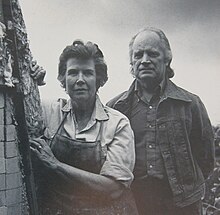Otto and Vivika Heino
Vivika + Otto Heino | |
|---|---|
 Vivika and Otto at The Pottery, Ojai | |
| Born | Vivien Place Aho Heino Vivika June 27, 1910 Caledonia, NY Otto April 20, 1915 East Hampton, CT |
| Died | Vivika September 1, 1995 Otto July 16, 2009 |
| Nationality | American |
| Known for | Ceramics |
| Movement | Arts and Crafts |
Otto Heino (April 20, 1915 – July 16, 2009) and Vivika Heino (June 27, 1910 – September 1, 1995)
Otto Heino
One of twelve children born of Finnish immigrants, Lena and August Heino, in
Military service
During World War II, Otto Heino served five years of active duty in the USAAF where he briefly worked on engines at a Rolls-Royce factory in England. He was assigned to the
Death
Otto Heino died of
Vivika Heino
Vivika was born Vivien Place in
Vivien Place started using the name Vivika while studying at the Swedish Applied Arts, in San Francisco, where teacher Margaret Gravandar thought everyone should have a Swedish name. (Even her mother started calling her that.)[5]
In 1941, Vivika received an M.F.A. from
Otto + Vivika
Otto and Vivika moved to California in 1952, where Vivika replaced Glen Lukens, head of ceramics department of the University of Southern California, during his sabbatical; she remained there for three years. Otto also taught at the university during this time. Also in 1952, she became a technical advisor for
In 1955, as they prepared to return home to Hopkinton, New Hampshire, she was invited to reorganize the ceramics department at the Chouinard Art Institute in Los Angeles, and remained there for eight years. During that time, they remodelled a store on Hoover Street into a studio and began selling their work directly to the public, with success. Otto worked full-time as a potter while Vivika taught; during the summer, they switched roles, Otto teaching and Vivika producing pottery.
Vivika helped organise and became a board member of the Southern California Designer Craftsmen, and later a trustee for the southwestern region of the American Craft Council. She travelled to nearby states to help organize craft groups, something she had experience with from her days at the League of New Hampshire Arts and Crafts.
After an eleven-year stay in California (originally expected to last two), Vivika accepted in 1963 an offer to teach at the Rhode Island School of Design, in Providence, Rhode Island. In 1965, the Heinos reopened their home and studio in Hopkinton, New Hampshire.
Teaching was a very important part of Vivika's life. Although he also enjoyed teaching, Otto preferred studio production. Over the years, Vivika accepted a number of short-term teaching assignments, punctuated by periods of studio work with Otto.
What you give away you have forever; what you keep to yourself, you lose." (Vivika Heino)[7]
They later returned to California, crossing the country in three moving vans, carrying 29 tons of materials. They purchased a house in Ojai, a small community in the mountains northwest of Los Angeles, built by Beatrice Wood, a friend since 1952. Their pottery studio, The Pottery, produced functional and decorative vessels, as well as architectural commissions.
The Heinos supported themselves as potters throughout their career. Clean lines and distinctive glazes mark their work; avoiding ceramic trends, they focused on traditional and utilitarian pottery. Glazes, however, are Heino's greatest legacy. The yellow glaze being their most famous one.[8] They were part of a generation that sought to redefine the relationship between ceramics and modern art.
Awards
- Gold Medal from the Sixth Biennale internationale de céramique d'art, in Vallauris, France. (1978)
- Silver Medal from the International Ceramics Exhibitions in Ostend, Belgium (1959)
Exhibitions
- American Craft Museum, New York City, New York
- County Art Museum and Craft Folk Art Museum, Los Angeles, California
- De Young Museum, San Francisco, California
- Museum of Fine Arts, Boston, Massachusetts
- Picasso Museum in Vallauris, France
- Smithsonian Institution, Washington, DC
- Craft & Folk Art Museum, Los Angeles
- Mingei Museum, San Diego, California
- Ventura County Museum
References
- ^ Social Security Death Index
- ^ Keeps, David A. "After all these years, potter Otto Heino...". Los Angeles Times. Retrieved on July 19, 2009.
- ^ Bud Anderson's P-51 Mustang "Old Crow" Web Page. Retrieved on July 19, 2009.
- ^ Otto Heino dies at 94; master potter created 'hearty and gutsy' pieces Los Angeles Times. Retrieved on July 26, 2009.
- ^ Levin, Elaine (1981-03-04). "Vivika and Otto Heino Oral History Interview". Archives of American Art. Smithsonian Institution. Retrieved 2006-10-13.
- ^ Smith, Paul J. (2004-03-01). "Interview with Susan Peterson". Archives of American Art. Smithsonian Institution. Retrieved 2006-10-13.
- ^ Levin, Elaine (October 1977). "Otto and Vivika Heino". Ceramics Monthly. 25: 38–44. Retrieved 2 August 2023 – via Google Books.
- ^ "After all these years, potter Otto Heino is still going strong. Just peek in his home and studio". www.latimes.com. 26 June 2008. Archived from the original on 2015-12-14.
External links
- "The Art of Vivika and Otto Heino". Exhibition background. Oakland Museum of California. July 2005. Archived from the original on 2006-09-17. Retrieved 2006-10-13.
- "Otto Heino, Ceramicist Who Elevated the Humble Pot to Art, Is Dead at 94". News Paper Article. New York Times. July 2009. Retrieved 2011-10-11.
